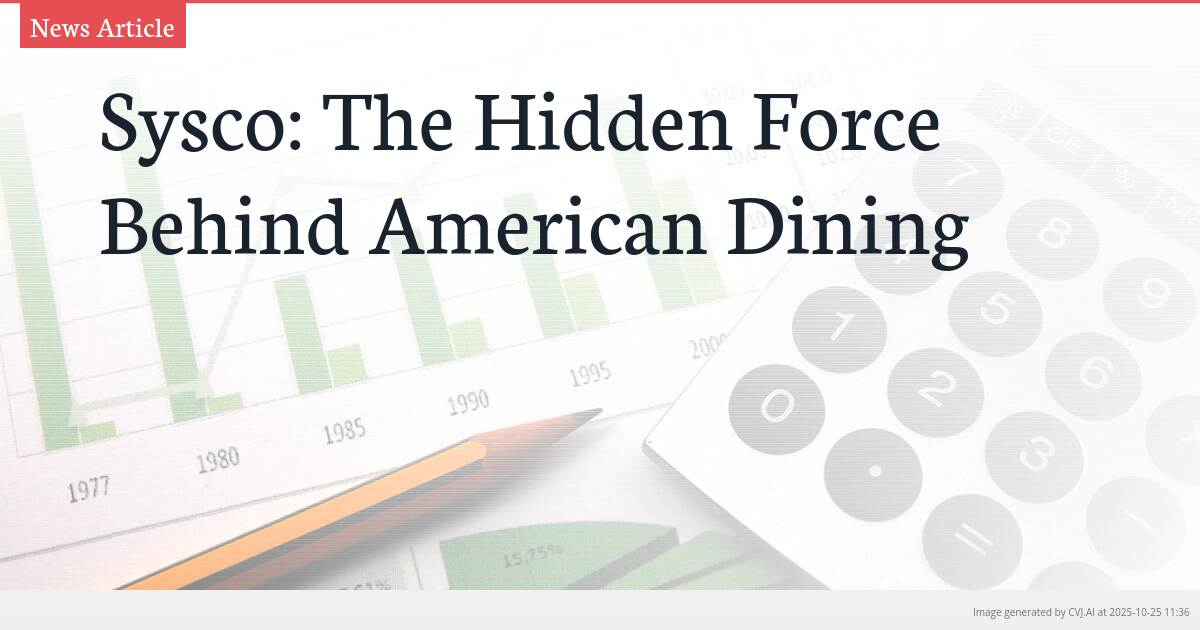This summary text is fully AI-generated and may therefore contain errors or be incomplete.
Introduction
Whether you’re dining at a fast food chain or a Michelin-starred restaurant, there’s a high probability your meal ingredients originated from the same source. Sysco operates as the dominant foodservice distributor in the United States, quietly shaping the American culinary landscape through its massive logistics network. This behind-the-scenes giant has become an invisible force in defining what appears on plates across the nation, leveraging its scale and standardization to influence everything from fast food burgers to fine dining entrees.
Key Points
- Supplies both fast food chains and high-end restaurants through the same distribution network
- Operates the largest foodservice logistics system in the United States
- Standardized product offerings have shaped consistent dining experiences nationwide
The Unseen Distribution Giant
Sysco Corporation stands as the dominant foodservice distributor in the United States, operating a massive logistics network that supplies ingredients to thousands of restaurants across the country. From fast food chains to Michelin-starred bistros, Sysco’s reach extends throughout the American dining ecosystem, making it one of the most influential yet least visible players in the food industry. The company’s extensive distribution system ensures that whether customers are eating in New York or California, there’s a strong likelihood their meal components passed through Sysco’s supply chain.
The scale of Sysco’s operation is staggering, with the company maintaining the largest foodservice logistics system in the United States. This network allows Sysco to supply both mass-market fast food establishments and high-end dining venues through the same distribution channels, creating an unprecedented level of standardization across the American restaurant landscape. The company’s ability to serve such diverse clientele speaks to both its operational efficiency and the homogenization of food sourcing in the United States.
Standardization and Its Impact on American Cuisine
Sysco’s product standardization has played a significant role in defining what American dining tastes like, sometimes quite literally. By providing consistent ingredients to restaurants nationwide, the company has helped create predictable dining experiences across different regions and restaurant types. This standardization enables restaurant chains to maintain quality control and cost consistency, but it also means that many independent restaurants end up serving similar ingredients to their chain competitors.
The company’s standardized product offerings have shaped consistent dining experiences from coast to coast, creating a culinary baseline that affects everything from burger toppings to salad ingredients. While this standardization provides operational benefits for restaurants through reliable supply and predictable costs, it also raises questions about regional culinary diversity and the authenticity of local dining experiences. The USD-driven efficiency of Sysco’s model has fundamentally changed how restaurants source their ingredients and manage their food costs.
This homogenization effect extends beyond just ingredients to include preparation methods, portion sizes, and even menu development, as restaurants increasingly rely on Sysco’s product catalog and culinary support services. The result is a national dining landscape where regional distinctions can become blurred, and independent restaurants may struggle to differentiate themselves from chains that use similar foundational ingredients.
The Logistics Behind the Meals
Sysco’s food logistics operation represents a marvel of supply chain management, moving billions of dollars worth of food products annually through a sophisticated network of distribution centers and transportation assets. The company’s ability to efficiently manage perishable inventory and deliver consistent quality has made it an indispensable partner for restaurants operating on thin margins. This logistical prowess allows Sysco to serve both large chain accounts and independent restaurants with equal reliability.
The restaurant supply chain managed by Sysco involves complex coordination of sourcing, warehousing, transportation, and last-mile delivery to ensure that fresh ingredients reach kitchens exactly when needed. This efficiency comes at the cost of diversity, as the scale required to maintain such a system necessitates product standardization and limited supplier options. The company’s dominance in foodservice distribution means that its operational decisions and product selections have ripple effects throughout the entire American restaurant industry.
Critiques and Industry Implications
While Sysco’s scale and efficiency provide clear benefits to restaurant operators, critics point to the homogenizing effect of such concentrated distribution power on American dining culture. The concern is that as more restaurants rely on the same limited pool of standardized ingredients, regional culinary traditions and unique local flavors may become increasingly rare. This standardization, driven by logistical efficiency and cost control, potentially limits culinary innovation and diversity in the United States.
The company’s behind-the-scenes role represents a fundamental but often overlooked aspect of the American food industry ecosystem, where distribution efficiency can shape culinary trends as much as chef creativity or consumer preferences. As the dominant player in foodservice distribution, Sysco’s product decisions and supply chain management practices influence menu development, food costs, and ultimately, what appears on American plates. The tension between operational efficiency and culinary diversity continues to define debates about the future of American dining.
📎 Read the original article on bloomberg.com

